Behavioural neuroscience advances in organizational behaviour research
Received: 05-Dec-2017 Accepted Date: Feb 05, 2018; Published: 12-Feb-2018
Citation: Chumg HF. Behavioural neuroscience advances in organizational behaviour research. J Behav Neurosci. 2017;1(1):1.
This open-access article is distributed under the terms of the Creative Commons Attribution Non-Commercial License (CC BY-NC) (http://creativecommons.org/licenses/by-nc/4.0/), which permits reuse, distribution and reproduction of the article, provided that the original work is properly cited and the reuse is restricted to noncommercial purposes. For commercial reuse, contact reprints@pulsus.com
The academic field of Behavioral Neuroscience, based on biology of behavior, has widely been widely explored in terms of exploratory behaviour of animal and human [1], especially focusing on physiological processes including learning and memory [2], social cognition [3], reward [4], decision making [5] and mechanisms of pain [6]. The growing number of relevant research, nowadays, have paid more attention to exploring how an individual’s behaviour or habits can be formed or built within an organization through combining organizational behaviour and behavioral neuroscience. This is mainly because, from the perspective of neuroscientists, the brain of human beings which has evolved over thousands of years could reflex their behaviour from automatic mechanism. Moreover, with the rapid change in economic environments, the development of any organization is invariably inseparable from innovation in order to enhance organizational performance and opportunities. Yet, organizational innovation may end in failure because it is hard to break employee’s resistance to change, original interests balance and stable psychological mechanism. It is owing to the fact that even if employees are aware of the benefits of organizational innovation, most of them who are content with current situation do not like to change their working behaviour and habits. This may be due to the relevant factors of a complex attitude system and behaviors. Meanwhile, a neuro scientific research study conducted with Cunningham and co-authors suggests that implicit attitude, and explicit attitude and emotion of an individual should be clearly distinguished and identified between each other [7]. Implicit attitude of individuals refers to sub-consciousness or unconsciousness under the prior accumulated experience and cognition of their life contexts. Such attitude reflected in social emotion, intention and behaviour of individuals seems more difficult to be measured. On the contrary, an individual’s explicit attitude, based on the reasoning process through the detailed analysis of process, the extension of belief system, the social norm and the contextual background information, formed or expressed by considering the various social expectations, social norms, and environmental factors can be evaluated through traditional method of selfreport [7,8]. Hence, it is obvious that most of research studies may acquire only an explicit attitude of individuals and cannot obtain an expression of the individual's true attitude, and the conclusions and explanations are suspected. An increasing number of researchers have taken into account about mirror neurons of individuals that can respond to support the broad social functions of nonverbal communication and implicit coordination, and can simulate behaviors, intentions and even the psychological state of individuals [9,10]. Kuenzi and Schminke in further state mirror neurons of individuals can perceive action, body language and micro expression of others when team members interact with each other [11]. As mentioned above, behavioral neuroscientists can further explore and understand the causes-and-effect of behavior and habits of individuals within the real context of social phenomena.
REFERENCES
- Kalueff AV, Zimbardo PG. Behavioral neuroscience, exploration, and KC Montgomery's legacy. Brain Res Rev 2007;53:328-331.
- Montgomery KC. The role of the exploratory drive in learning. J Comp Physiol Psychol 1954;47:60-64.
- Jost JT, Amodio DM. Political ideology as motivated social cognition: Behavioral and Neuroscientific evidence. Motivation and Emotion 2012;36:55-64.
- Morita K, Morishima M, Sakai K, et al. Dopaminergic control of motivation and reinforcement learning: a closed-circuit account for reward-oriented behavior. J Neurosci 2013;33:8866-8890.
- Hsu M, Bhatt M, Adolphs R, et al. Neural systems responding to degrees of uncertainty in human decision-making. Sci 2005;310:1680-1683.
- Bolles RC, Fanselow MS. A perceptual-defensive-recuperative model of fear and pain. Behav Brain Sci 1980;3:291-323.
- Cunningham WA, Zelazo PD, Packer DJ, et al. The iterative reprocessing model: A multilevel framework for attitudes and evaluation. Soc Cogn 2007;25:736-760.
- Gawronski B, Bodenhausen GV. Associative and propositional processes in evaluation: an integrative review of implicit and explicit attitude change Psychol Bull 2006;132:692-731.
- Rizzolatti G, Craighero L. The mirror-neuron system. Annu Rev Neurosci 2004;27:169-192.
- Rizzolatti G, Fabbri-Destro M. The mirror system and its role in social cognition. Curr Opin Neurobiol 2008;18:179-184.
- Kuenzi M, Schminke M. Assembling fragments into a lens: A review, critique, and proposed research agenda for the organizational work climate literature. J Manag 2009;35:634-717.





